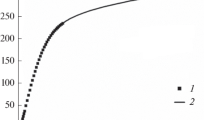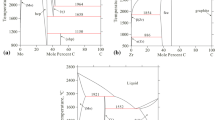Abstract
Based on an assessment of the available experimental thermochemical and phase diagram information available, the phase equilibria of the C-Hf-Zr system were calculated. The G of the individual phases was described with thermodynamic models. The liquid phase was described as a substitutional solution using the Redlich-Kister formalism for excess G. Graphite was treated as a stoichiometric phase. The solid solutions of carbon in α(Hf,Zr) and β(Hf,Zr), as well as the non-stoichiometric phase (Hf,Zr)C1−x, were represented as interstitial solid solutions using the compound energy model with two sublattices. The parameters in the models were determined by computerized optimization using selected experimental data. A detailed comparison was made between calculation and experimental data.
Similar content being viewed by others
References
O. Redlich and A.T. Kister: “The Algebraic Representation of Thermodynamic Properties and the Classification of Solids,” Ind. Eng. Chem., 1948, 40, pp. 345–48.
R.B. Russell: “On the Zr-Hf System,” J. Appl. Phys., 1953, 24, p. 232.
E.T. Hayes and D.K. Deardorff: U.S. At. Energy Comm. USBM-U-345, August 1957. Cited in D.K. Deardorff, O.N. Carlson, and H. Kato: “The Metallurgy of Hafnium,” D.E. Thomas and E.T. Hayes, ed., U.S. At. Energy Comm., 1960, pp. 191–210.
O. Kubaschewski, “Free Energy and Phase Diagrams” in Thermodynamics of Nuclear Materials, Proc. Symp. Vienna, IAEA, Vienna, 1962, p. 219.
T.F. Fedorov and E.I. Gladyshevskii: “Phase Equilibria in Ternary Systems of Transition Metals of Group IV and V and Carbon,” Soviet Powder Metallurgy and Metal Ceram (translated from Poroshkovaya Metallurgiya, Kiev,) 1965, 4, pp. 27–29.
C.E. Brukl and D.P. Harmon: “Ternary Phase Equilibria in Transition Metal-Boron-Carbon-Silicon Systems; Part II. Ternary Systems. Vol. 4. The Ti-Zr-C, Ti-Hf-C and Zr-Hf-C Systems,” Tech. Rep. AFML-TR-65-2, Part II, 1966, IV.
R.F. Domagala: “The Zirconium-Hafnium System,” J. Less-Common Met., 1969, 11, p. 70.
D.P. Harmon: “USAF Tech. Rept. AFML-TR-65-2, Part II, Vol. VI, August 1966” in E. Rudy, ed., Ternary Phase Equilibria in Transition Metal-Boron-Carbon-Silicon Systems. Part V., Compendium of Phase Diagram Data, Tech. Rep. AFML-TR-62-2, Air Force Materials Laboratory, Wright-Patterson Air Force Base, OH, 1969, p. 73.
E. Rudy and S. Windisch: “Ternary Phase Equilibria in Transition Metal-Boron-Carbon-Silicon Systems” in Part II Ternary Systems, Vol. XIII. Phase Diagrams of the Systems Ti-B-C, Zr-B-C and Hf-B-C, Report AFML-TR-65-2, Air Force Materials Laboratory, Wright-Patterson Air Force Base, OH, 1966, p. 207. See also “Compendium of Phase Diagram Data,” AFML-TR-65-2, Part V, ibid, 1969.
E.K. Storms: The Refractory Carbides, Academic. Press, New York, 1967.
J.O. Betterton and J.O. Scarbrough: “Low-Temperature Specific Heats of Zr-Ti, Zr-Hf, and Zr-Sc Alloys,” Phys. Rev., 1958, 168, p. 715.
R.F. Domagala and R. Ruh: “The System Zirconium-Hafnium-Oxygen,” Trans. ASM, 1969, 62, p. 915.
M. Hoch, M.G. Hapase, and S. Yamauchi: “Thermodynamic Properties of Ternary Refractory Carbides,” J. Electrochem. Soc., 1971, 118, p. 1503.
C.K. Jun and M. Hoch: “Thermodynamic Properties of Ternary Refractory Carbides,” J. Electrochem. Soc., 1971, 118, p. 1498.
L. Kaufman and L.E. Tanner: “Coupled Phase Diagrams and Thermochemical Descriptions of Titanium-Beryllium, Zirconium-Beryllium and Hafnium-Beryllium Systems,” Calphad, 1979, 3, p. 91.
L. Ming, M.H. Manghnani, and K.W. Katahara: “Investigation of α → ε Transformation in the Zr-Hf System to 42 GPa,” J. Appl. Phys., 1981, 52, p. 1332.
J.P. Abriata, J.C. Bolcich, and H.A. Peretti: “The Hf-Zr (Hafnium-Zirconium) System,” Bull. Alloy Phase Diagrams, 1982, 3(1), pp. 29–34.
B. Sundman, B. Jansson, and J.-O. Andersson: “The ThermoCalc Databank System,” Calphad, 1985, 9, pp. 153–90.
J.-O. Andersson, A. Fernandez Guillermet, M. Hillert, B. Jansson, and B. Sundman: “A Compound-Energy Model of Ordering in a Phase with Sites of Different Coordination Numbers,” Acta Metall., 1986, 34(3), pp. 437–45.
T.B. Massalski, P.R. Subramanian, H. Okamoto, and L. Kacprzak: Binary Alloy Phase Diagrams, 2nd ed., Vol. 1–3, ASM International, Materials Park, OH, 1990.
B. Sundman, “Review of Alloys Modelling,” Anales de Fisica, Serie B 1990, 86, pp. 69–82.
A.T. Dinsdale, “SGTE Data for Pure Elements,” Calphad, 1991, 15, pp. 319–427.
A. Fernández Guillermet: “Analysis of Thermochemical Properties and Phase Stability in the Zirconium-Carbon System,” J. Alloys Compd., 1995, 217, pp. 69–89.
H. Bittermann and P. Rogl: “Critical Assessment and Thermodynamic Calculation of the Binary System Hafnium-Carbon (Hf-C),” J. Phase Equilibria, 1997, 18(4), pp. 344–56.
Author information
Authors and Affiliations
Rights and permissions
About this article
Cite this article
Bittermann, H., Rogl, P. Critical assessment and thermodynamic calculation of the ternary system C-Hf-Zr (Carbon-Zirconium-Hafnium). JPE 23, 218 (2002). https://doi.org/10.1361/105497102770331703
Received:
Revised:
DOI: https://doi.org/10.1361/105497102770331703




